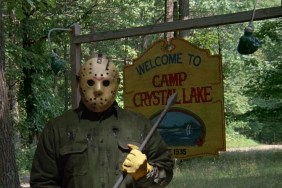A look back at Topps’ versus tale!

Jason Voorhees went to hell. And Leatherface, well, he was still carvin’ meat and playing with his Speak & Spell somewhere in the backwoods of Texas. On the cinematic front, it was looking pretty final for both the Friday the 13th and Texas Chainsaw Massacre franchises in the early ’90s. And with these two powerhouse terror titans under their roof, New Line Cinema began to explore how it could further Jason and Leatherface’s legacy. Of course, the studio also housed Freddy Krueger. And while executives there masterminded a business plan to pit Jason versus Freddy (a plan that would call for countless scripts), Topps Comics orchestrated a slasher smackdown of their own that would call for machete to clash with chainsaw.
In 1995, Topps published the three-part “Jason vs. Leatherface,” a raucous, chunky, black-hearted horror-comedy that delve into the family dynamics of Leatherface’s crew and presented an unseen, meditative side to our favorite hockey mask-wearing thug. At the time, Topps – known widely for their collectable trading cards (not to mention their gleefully deranged Mars Attacks! line) – was two years into the comics biz having published adaptations of Jason Goes to Hell, Bram Stoker’s Dracula and Jurassic Park. Novelist Nancy A. Collins and New Line’s David Imhoff are credited with the slice of life tale that unfolds in “Jason vs. Leatherface,” but it’s Collins who pulled scripting duties. She waded through the muddy trenches writing “Swamp Thing” prior to this, so it’s no surprise the driving force that brings Jason and Leatherface together is an act of ecological damage.
In part one, “Goin’ South,” we discover Jason is still chained up at the bottom of Crystal Lake – implying this occurs sometime after Friday the 13th: Part VII – and that an industrial facility now rests on the lake’s shore, pumping hazardous material into the water. This toxic waste doesn’t turn Jason into an infant, curiously enough (that’s what deadly goo apparently does to the dude, as we learned in Jason Takes Manhattan). But when the facilityâs developers decide to dredge the lake and haul its contents, via train, out of the state, Jason is brought to the surface and dropped into a train car. He escapes, kills a hobo, a dog and the crew, derailing the train in the process. Doing one of those cool, “I’m an action star and I’ve got shit blowin’ up behind me” Jason saunters away from this destruction intact (a panel brought to explosive life by illustrator Jeff Butler).

Collins plays with the personas of the Leatherface family at this point when Jason wanders into Sawyerville, Texas and meets the Hitchhiker – a gnarly, scowling creep with a swastika on his temple – who spouts Chop Top’s signature lines like, “Dog will hunt!” Jason also goes toe-to-toe with Leatherface right away. And just when Jason has the upper hand (“Shit fire! He got the saw!”), the two killer come to an instant mutual understanding when an innocent victim gets in the way and loses his head. The Hitchhiker and Leatherface lead Jason back to the house where they greet “Cook,” an apron-wearing fella who is just shy of being Tinker from Jeff Burr’s threequel Leatherface. So, you see, Collins plays with the family members a bit and presents her own riff on them. Grandpa is still here. There’s grandma as well. And Leatherface’s room looks like any kid’s room with a giant poster of Conan hanging above the bed, a Wolf Man doll sitting on the dresser and an image of Frankenstein looming proudly near a lamp made from a skull.
Through the following two issues, “A Day in the Life⦔ and “Face Off,” Collins introduces Jason into the Leatherface’s cannibal clan and he learns how they work, hunt and eat. Naturally, Jason doesn’t work or eat, but he’s a supreme killing machine and Collins shies away from letting us see Jason in action again when Hitchhiker takes him out to stalk a bickering couple who have broken down on the road. The kills are never realized and we only see the outcome. Collins is less concerned with the body count here than she is the psychology of Jason and the certain kinship that’s stirring inside him, the thing holding him back from killing Leatherface and his family. It all connects to Jason’s abusive past, which unfolds through flashbacks and links to the current abuse he witnesses when the Hitchhiker unleashes his fury on Leatherface. Ultimately, Jason’s intolerance for familial violence is what ignites the final confrontation he has with Leatherface and after a super brawl, Jason is left alone yet again.
The moral of the story for him? Feelings are for sissies

“Jason vs. Leatherface” is layered with more depth than one expects, which is welcome. Jason and Leatherface, at best, are like Will Farrell and John Reilly in Step Brothers. Feuding until that moment where it dawns on them: “Did we just become best friends?!” “Yup!” The conflict between them is removed too early on, however, and Leatherface is relegated to a whimpering buffoon. A victim. Jason, meanwhile, acts as a stoic observer moving from one scenario to the next, sometimes interacting (more often than not intervening in Hitchhiker’s reign of violence) but mostly not having much to do. He’s a beacon of sanity in a house filled lunatics. The series favors Leatherface, narratively speaking. (This is a lesson the Freddy vs. Jason team should have learned from which was decidedly heavy on Freddy.) In the end, however, Collins reinforces that it is Jason’s journey and that he is the victor in this battle.
Still, there are too many missed opportunities in “Jason vs. Leatherface” and you yearn to see the two working side by side. But, you have to hand it to Collins for plausibly bringing the two together, and the read is never dull. Nothing could ever match the promise Simon Bisley brought to all three covers in the series. That art packed a punch square to your nose and was pure f**kin’ rock ‘n roll.
Since ’95, the series has not been reprinted making all three issues collector’s items if you can find them at a convention.





Source: Ryan Turek, Managing Editor









